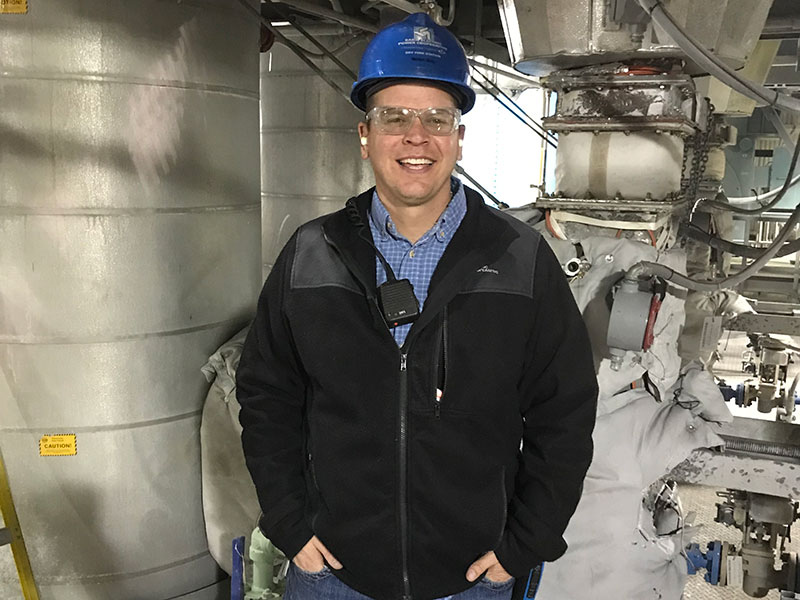- Products
- About us
- Responsibility
- Environment
- News
- Contact us
- Careers
-
When a project to modify the air quality control system at Dry Fork Station near Gillette, Wyoming, began, the project team had no idea it would end up saving the cooperative $1 million annually.
“When I came to the co-op in 2010, Dry Fork (Station) was being built. Right out of commissioning, I got assigned to the lime system,” says Nolan Bray, plant engineer at Dry Fork Station.
But a scrubber, or equipment that removes sulfur dioxide (SO2) from exhaust flue gases, that was initially installed at the plant never had its hydrators fully commissioned, so the team went to work to finish that important step. The hydrators are critical because they take the quick lime and hydrate it. During this process, they fracture the quick lime and increase the surface area. This is a dry hydration process so it doesn’t get the lime wet; it causes the quick lime to interact with water and produce hydrated lime.
Getting the hydrators 100% commissioned was a challenge because the people who designed the scrubber were not the same people who built it, and the hydrators at Dry Fork Station are rare.

“The only fluidized bed hydrators we know of are ours and some in Turkey,” says Bray. “We had a lot to learn and not a lot of people to lean on. Out of necessity, we started finishing the commission, and we made it through that and got the system working reliably.”
“Nolan did all of the research and testing and put all of the changes together, and I helped by making sure operations crews ran the hydrator the way Nolan wanted it to operate,” says Bob Donovan, Dry Fork Station operations superintendent. “This project would not be a success without the cooperation and dedication from all of the employees at Dry Fork. It was definitely a team effort to get this completed.”
Once Dry Fork Station completed that stage and the system was fully commissioned, the team noticed that a lot of lime was being expended. Hydrated lime (calcium hydroxide) is used to remove SO2 from the flue gas. It causes the sulfur dioxide to react with the calcium hydroxide to form calcium sulfite which can then be captured in the bag house and removed from the flue gas.
“We measured our efficiency, and we were high. An ideal stoichiometric ratio is 1:1, between lime consumed versus SO2 removed. In other words one pound of lime is required to remove one pound of sulfur. The scrubber at Dry Fork Station was designed to operate at a 1.42 ratio. In 2018, we measured a stoichiometric ratio of 2.04, so we had some work to do,” says Bray.
With this data in mind, the team focused on automating the lime flow into the scrubber and adjusting the scrubber based on the dew point of the flue gas. Dew point is the temperature at which water droplets begin to condense and form, and is important because if the temperature of the metal surfaces is lower than the sulfuric acid dew point, severe corrosion may occur.
“We’ve slowly been moving this route because you can’t make a change in operations overnight, and by 2019 we started seeing the benefit,” says Bray. “We reached payback in the first year, and the project paid for itself with the savings.”
“We set up the automatic lime feed to the scrubber to control SO2 emissions, and that really helped lower our operation costs,” says Donovan.

Bray says that previously Dry Fork Station didn’t have the ability to control the scrubber outlet temperature so they never had a true dew point set point. A humidity probe was added to the flue gas that showed the relative humidity, thus allowing the dew point to be calculated.
The team continues adjusting the scrubber to operate closer to the dew point, however the scrubber can’t be run at true dew point because that would encourage corrosion.
“When we switched to approach temperature where we can follow dew point, it allowed us to keep a consistent approach temperature,” says Bray. “We started at 55 degrees (Farenheit) approach above dew point, and now we’re at 46 degrees. A lot of utilities run at 35 degrees approach. We need more work to get down there.”
Donovan says dew point control and automation of lime flow are what brought a huge reduction in lime usage accounting for $1 million in total savings each year.
“Lowering the approach temperature the system runs on, controlling the lime, and optimizing the hydrators all helped to increase efficiency, too,” says Donovan.
Going forward, the team plans to continue looking for ways to increase efficiencies to save even more money. But for now, they’re proud to have brought substantial savings to the cooperative.
“If you had told me that we would help save this company $1 million at the beginning of the project, I’d have thought you didn’t know what you’re taking about,” says Bray. “I couldn’t foresee how effective this project would be.”
Dakota Gasification Company
Headquarters:
1717 East Interstate Avenue | Bismarck, ND 58503-0564 USA
701.223.0441 | 1.800.242.2372
Great Plains Synfuels Plant
420 County Road 26
Beulah, ND 58523-9400 USA
701-873-2100
A subsidiary of:
Basin Electric wants all interested and qualified candidates to apply for employment opportunities. If you are an applicant with a disability who is unable to use our online tools to search and apply for jobs, or who needs other assistance or accommodations, please contact us at 701-223-0441. Please indicate the specifics of the assistance needed or provide your contact information, and a Basin Electric Human Resources representative will contact you. Basin Electric is an Equal Employment Opportunity Employer regarding race, color, religion, sex, sexual orientation, gender identity, national origin, disability, and veterans status.